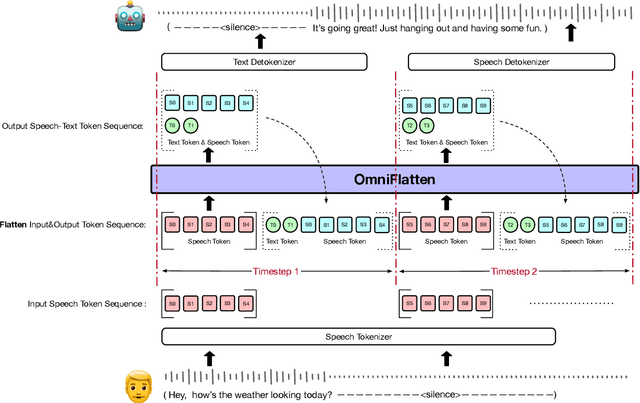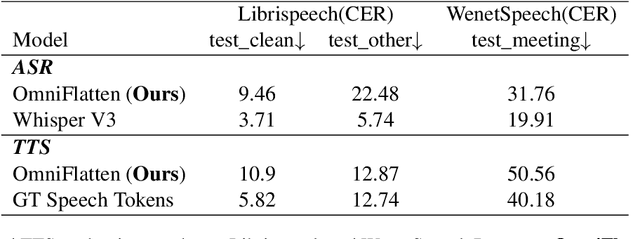Qinglin Zhang
FunAudio-ASR Technical Report
Sep 15, 2025Abstract:In recent years, automatic speech recognition (ASR) has witnessed transformative advancements driven by three complementary paradigms: data scaling, model size scaling, and deep integration with large language models (LLMs). However, LLMs are prone to hallucination, which can significantly degrade user experience in real-world ASR applications. In this paper, we present FunAudio-ASR, a large-scale, LLM-based ASR system that synergistically combines massive data, large model capacity, LLM integration, and reinforcement learning to achieve state-of-the-art performance across diverse and complex speech recognition scenarios. Moreover, FunAudio-ASR is specifically optimized for practical deployment, with enhancements in streaming capability, noise robustness, code-switching, hotword customization, and satisfying other real-world application requirements. Experimental results show that while most LLM-based ASR systems achieve strong performance on open-source benchmarks, they often underperform on real industry evaluation sets. Thanks to production-oriented optimizations, FunAudio-ASR achieves SOTA performance on real application datasets, demonstrating its effectiveness and robustness in practical settings.
Say More with Less: Variable-Frame-Rate Speech Tokenization via Adaptive Clustering and Implicit Duration Coding
Sep 04, 2025Abstract:Existing speech tokenizers typically assign a fixed number of tokens per second, regardless of the varying information density or temporal fluctuations in the speech signal. This uniform token allocation mismatches the intrinsic structure of speech, where information is distributed unevenly over time. To address this, we propose VARSTok, a VAriable-frame-Rate Speech Tokenizer that adapts token allocation based on local feature similarity. VARSTok introduces two key innovations: (1) a temporal-aware density peak clustering algorithm that adaptively segments speech into variable-length units, and (2) a novel implicit duration coding scheme that embeds both content and temporal span into a single token index, eliminating the need for auxiliary duration predictors. Extensive experiments show that VARSTok significantly outperforms strong fixed-rate baselines. Notably, it achieves superior reconstruction naturalness while using up to 23% fewer tokens than a 40 Hz fixed-frame-rate baseline. VARSTok further yields lower word error rates and improved naturalness in zero-shot text-to-speech synthesis. To the best of our knowledge, this is the first work to demonstrate that a fully dynamic, variable-frame-rate acoustic speech tokenizer can be seamlessly integrated into downstream speech language models. Speech samples are available at https://zhengrachel.github.io/VARSTok.
OmniDRCA: Parallel Speech-Text Foundation Model via Dual-Resolution Speech Representations and Contrastive Alignment
Jun 11, 2025Abstract:Recent studies on end-to-end speech generation with large language models (LLMs) have attracted significant community attention, with multiple works extending text-based LLMs to generate discrete speech tokens. Existing approaches primarily fall into two categories: (1) Methods that generate discrete speech tokens independently without incorporating them into the LLM's autoregressive process, resulting in text generation being unaware of concurrent speech synthesis. (2) Models that generate interleaved or parallel speech-text tokens through joint autoregressive modeling, enabling mutual modality awareness during generation. This paper presents OmniDRCA, a parallel speech-text foundation model based on joint autoregressive modeling, featuring dual-resolution speech representations and contrastive cross-modal alignment. Our approach processes speech and text representations in parallel while enhancing audio comprehension through contrastive alignment. Experimental results on Spoken Question Answering benchmarks demonstrate that OmniDRCA establishes new state-of-the-art (SOTA) performance among parallel joint speech-text modeling based foundation models, and achieves competitive performance compared to interleaved models. Additionally, we explore the potential of extending the framework to full-duplex conversational scenarios.
ShieldVLM: Safeguarding the Multimodal Implicit Toxicity via Deliberative Reasoning with LVLMs
May 20, 2025Abstract:Toxicity detection in multimodal text-image content faces growing challenges, especially with multimodal implicit toxicity, where each modality appears benign on its own but conveys hazard when combined. Multimodal implicit toxicity appears not only as formal statements in social platforms but also prompts that can lead to toxic dialogs from Large Vision-Language Models (LVLMs). Despite the success in unimodal text or image moderation, toxicity detection for multimodal content, particularly the multimodal implicit toxicity, remains underexplored. To fill this gap, we comprehensively build a taxonomy for multimodal implicit toxicity (MMIT) and introduce an MMIT-dataset, comprising 2,100 multimodal statements and prompts across 7 risk categories (31 sub-categories) and 5 typical cross-modal correlation modes. To advance the detection of multimodal implicit toxicity, we build ShieldVLM, a model which identifies implicit toxicity in multimodal statements, prompts and dialogs via deliberative cross-modal reasoning. Experiments show that ShieldVLM outperforms existing strong baselines in detecting both implicit and explicit toxicity. The model and dataset will be publicly available to support future researches. Warning: This paper contains potentially sensitive contents.
AgiBot World Colosseo: A Large-scale Manipulation Platform for Scalable and Intelligent Embodied Systems
Mar 09, 2025Abstract:We explore how scalable robot data can address real-world challenges for generalized robotic manipulation. Introducing AgiBot World, a large-scale platform comprising over 1 million trajectories across 217 tasks in five deployment scenarios, we achieve an order-of-magnitude increase in data scale compared to existing datasets. Accelerated by a standardized collection pipeline with human-in-the-loop verification, AgiBot World guarantees high-quality and diverse data distribution. It is extensible from grippers to dexterous hands and visuo-tactile sensors for fine-grained skill acquisition. Building on top of data, we introduce Genie Operator-1 (GO-1), a novel generalist policy that leverages latent action representations to maximize data utilization, demonstrating predictable performance scaling with increased data volume. Policies pre-trained on our dataset achieve an average performance improvement of 30% over those trained on Open X-Embodiment, both in in-domain and out-of-distribution scenarios. GO-1 exhibits exceptional capability in real-world dexterous and long-horizon tasks, achieving over 60% success rate on complex tasks and outperforming prior RDT approach by 32%. By open-sourcing the dataset, tools, and models, we aim to democratize access to large-scale, high-quality robot data, advancing the pursuit of scalable and general-purpose intelligence.
AISafetyLab: A Comprehensive Framework for AI Safety Evaluation and Improvement
Feb 24, 2025Abstract:As AI models are increasingly deployed across diverse real-world scenarios, ensuring their safety remains a critical yet underexplored challenge. While substantial efforts have been made to evaluate and enhance AI safety, the lack of a standardized framework and comprehensive toolkit poses significant obstacles to systematic research and practical adoption. To bridge this gap, we introduce AISafetyLab, a unified framework and toolkit that integrates representative attack, defense, and evaluation methodologies for AI safety. AISafetyLab features an intuitive interface that enables developers to seamlessly apply various techniques while maintaining a well-structured and extensible codebase for future advancements. Additionally, we conduct empirical studies on Vicuna, analyzing different attack and defense strategies to provide valuable insights into their comparative effectiveness. To facilitate ongoing research and development in AI safety, AISafetyLab is publicly available at https://github.com/thu-coai/AISafetyLab, and we are committed to its continuous maintenance and improvement.
Uni-Retrieval: A Multi-Style Retrieval Framework for STEM's Education
Feb 09, 2025Abstract:In AI-facilitated teaching, leveraging various query styles to interpret abstract text descriptions is crucial for ensuring high-quality teaching. However, current retrieval models primarily focus on natural text-image retrieval, making them insufficiently tailored to educational scenarios due to the ambiguities in the retrieval process. In this paper, we propose a diverse expression retrieval task tailored to educational scenarios, supporting retrieval based on multiple query styles and expressions. We introduce the STEM Education Retrieval Dataset (SER), which contains over 24,000 query pairs of different styles, and the Uni-Retrieval, an efficient and style-diversified retrieval vision-language model based on prompt tuning. Uni-Retrieval extracts query style features as prototypes and builds a continuously updated Prompt Bank containing prompt tokens for diverse queries. This bank can updated during test time to represent domain-specific knowledge for different subject retrieval scenarios. Our framework demonstrates scalability and robustness by dynamically retrieving prompt tokens based on prototype similarity, effectively facilitating learning for unknown queries. Experimental results indicate that Uni-Retrieval outperforms existing retrieval models in most retrieval tasks. This advancement provides a scalable and precise solution for diverse educational needs.
MinMo: A Multimodal Large Language Model for Seamless Voice Interaction
Jan 10, 2025



Abstract:Recent advancements in large language models (LLMs) and multimodal speech-text models have laid the groundwork for seamless voice interactions, enabling real-time, natural, and human-like conversations. Previous models for voice interactions are categorized as native and aligned. Native models integrate speech and text processing in one framework but struggle with issues like differing sequence lengths and insufficient pre-training. Aligned models maintain text LLM capabilities but are often limited by small datasets and a narrow focus on speech tasks. In this work, we introduce MinMo, a Multimodal Large Language Model with approximately 8B parameters for seamless voice interaction. We address the main limitations of prior aligned multimodal models. We train MinMo through multiple stages of speech-to-text alignment, text-to-speech alignment, speech-to-speech alignment, and duplex interaction alignment, on 1.4 million hours of diverse speech data and a broad range of speech tasks. After the multi-stage training, MinMo achieves state-of-the-art performance across various benchmarks for voice comprehension and generation while maintaining the capabilities of text LLMs, and also facilitates full-duplex conversation, that is, simultaneous two-way communication between the user and the system. Moreover, we propose a novel and simple voice decoder that outperforms prior models in voice generation. The enhanced instruction-following capabilities of MinMo supports controlling speech generation based on user instructions, with various nuances including emotions, dialects, and speaking rates, and mimicking specific voices. For MinMo, the speech-to-text latency is approximately 100ms, full-duplex latency is approximately 600ms in theory and 800ms in practice. The MinMo project web page is https://funaudiollm.github.io/minmo, and the code and models will be released soon.
OmniFlatten: An End-to-end GPT Model for Seamless Voice Conversation
Oct 23, 2024



Abstract:Full-duplex spoken dialogue systems significantly advance over traditional turn-based dialogue systems, as they allow simultaneous bidirectional communication, closely mirroring human-human interactions. However, achieving low latency and natural interactions in full-duplex dialogue systems remains a significant challenge, especially considering human conversation dynamics such as interruptions, backchannels, and overlapping speech. In this paper, we introduce a novel End-to-End GPT-based model OmniFlatten for full-duplex conversation, capable of effectively modeling the complex behaviors inherent to natural conversations with low latency. To achieve full-duplex communication capabilities, we propose a multi-stage post-training scheme that progressively adapts a text-based large language model (LLM) backbone into a speech-text dialogue LLM, capable of generating text and speech in real time, without modifying the architecture of the backbone LLM. The training process comprises three stages: modality alignment, half-duplex dialogue learning, and full-duplex dialogue learning. Throughout all training stages, we standardize the data using a flattening operation, which allows us to unify the training methods and the model architecture across different modalities and tasks. Our approach offers a straightforward modeling technique and a promising research direction for developing efficient and natural end-to-end full-duplex spoken dialogue systems. Audio samples of dialogues generated by OmniFlatten can be found at this web site (https://omniflatten.github.io/).
Integrating Audio, Visual, and Semantic Information for Enhanced Multimodal Speaker Diarization
Aug 22, 2024



Abstract:Speaker diarization, the process of segmenting an audio stream or transcribed speech content into homogenous partitions based on speaker identity, plays a crucial role in the interpretation and analysis of human speech. Most existing speaker diarization systems rely exclusively on unimodal acoustic information, making the task particularly challenging due to the innate ambiguities of audio signals. Recent studies have made tremendous efforts towards audio-visual or audio-semantic modeling to enhance performance. However, even the incorporation of up to two modalities often falls short in addressing the complexities of spontaneous and unstructured conversations. To exploit more meaningful dialogue patterns, we propose a novel multimodal approach that jointly utilizes audio, visual, and semantic cues to enhance speaker diarization. Our method elegantly formulates the multimodal modeling as a constrained optimization problem. First, we build insights into the visual connections among active speakers and the semantic interactions within spoken content, thereby establishing abundant pairwise constraints. Then we introduce a joint pairwise constraint propagation algorithm to cluster speakers based on these visual and semantic constraints. This integration effectively leverages the complementary strengths of different modalities, refining the affinity estimation between individual speaker embeddings. Extensive experiments conducted on multiple multimodal datasets demonstrate that our approach consistently outperforms state-of-the-art speaker diarization methods.
 Add to Chrome
Add to Chrome Add to Firefox
Add to Firefox Add to Edge
Add to Edge